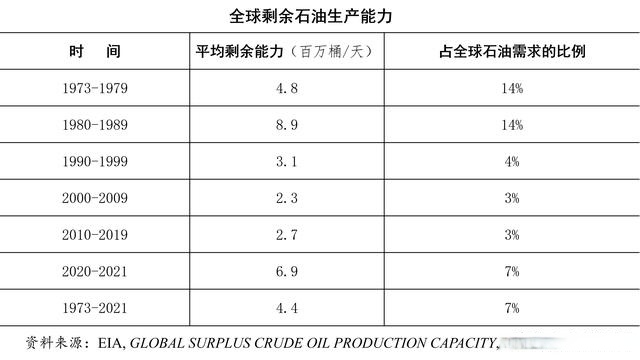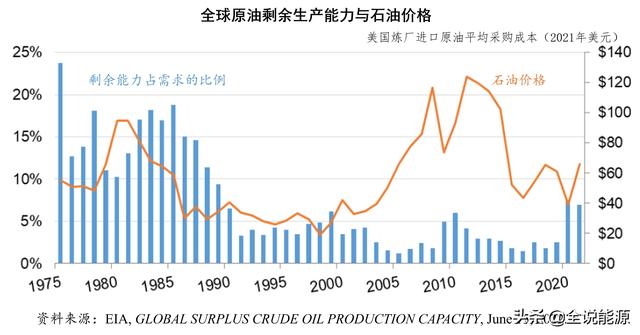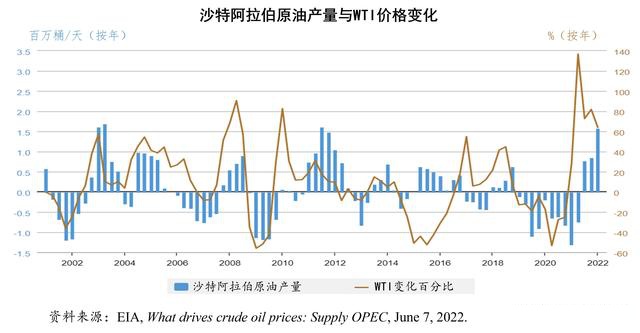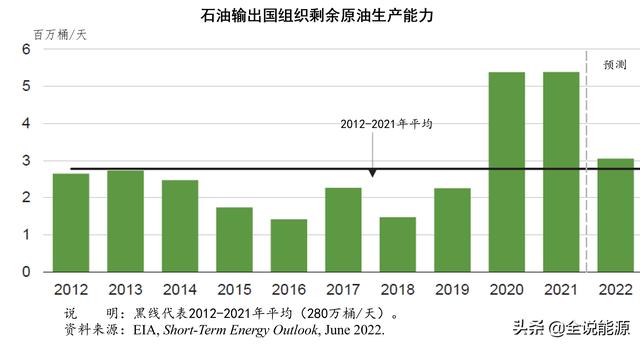How many remaining crude oil production capacity is there in the world?
Author:Speaking of energy Time:2022.07.01
File number: A349/0369
Published time: June 28, 2022
How many remaining crude oil production capacity is there in the world?
The global surplus crude oil production capacity is closely related to oil prices. In 1985, it reached 11.3 million barrels per day. It was at the lowest level in 2000-2009. In May 2022, it was only 3.28 million barrels per day.
Wang Nengquan
Since the second half of 2021, international oil prices have continued to rise. The Russian and Ukraine War, which broke out on February 24, 2022, promoted oil prices to break through the $ 100 and $ 110 mark per barrel on March 1 and 2, respectively. It rose to $ 139.13 per barrel, and the global energy crisis was increasing. Faced with rising international oil prices, many oil consumer countries in the United States and the world have called on Saudi Arabia and other petroleum exporting countries (OPEC) oil -producing countries to increase oil output and alleviate the intensified supply and demand of the international oil market. From the perspective of market observation and research, an important issue is whether Saudi Arabia and OPEC have the ability to increase oil output. According to the data and data of the US Energy Information Administration, this article will introduce the historical revolution, the relationship between the changes in international oil prices and the current status quo of the global surplus crude oil production capacity. The US Energy Information Agency believes that in May 2022, the global surplus crude oil production capacity was only 3.28 million barrels per day, and less than half of the average level in 2021. This explains and explains why international oil prices have been used since the second half of 2021. Continuously rising and may indicate the situation of the international oil market tension in the future.
Definition of remaining crude oil production capacity
What is the production capacity of surplus crude oil? Each institution has its own definition and explanation. The US Energy Information Agency believes that the remaining crude oil production capacity refers to the largest existing crude oil production capacity that can be put into production within 30 days and can last at least 90 days.
The US Energy Information Administration emphasized that the assessment of remaining crude oil production capacity does not include the output of crude oil due to accidental or interrupts (including sanctions), because oil production countries cannot enable these crude oil output to enter the international oil market independently. Based on this limitation, the US Energy Information Administration has excluded Iran, Libya, Venezuela, and Russian crude oil output currently discontinued to be eliminated within the estimation of remaining crude oil production capabilities around the world.
Since 2002, in the monthly "Short-Term Energy Outlook (STE", the US Energy Information Administration evaluates OPEC's crude oil production capacity and remaining crude oil production capacity. At present, the US Energy Information Administration's evaluation of OPEC crude oil production capacity and remaining crude oil production capacity can be traced back to 1970. In addition to OPEC, the US Energy Information Administration also evaluates the crude oil production capacity of non -oil output countries (non -OPEC) and the remaining crude oil production capacity. Country, but currently withdrawn from OPEC's oil production country.
How to evaluate the global surplus crude oil production capacity, the US Energy Information Administration explained and explained from the methodology.
Regarding the evaluation of OPEC's surplus crude oil production capacity, the US Energy Information Administration pointed out that in the past for a long time, it used the concept of total liquid oil production as the standardization basis for all data, because it was released by OPEC oil production before 2003 in 2003 Ability data, the total output of all liquid oil is used. However, the data of OPEC oil production capacity from 2003 to 2021 refers to crude oil, excluding the output of condensate oil. In this way, for the consistency of data, the US Energy Information Administration unified the data of the total output of OPEC liquid oil from 1970 to 2021. The reason is to add non -crude oil output to data from 2003 to 2021. The total production capacity of OPEC liquid oil.
The US Energy Information Administration believes that from the revised OPEC liquid oil total production capacity, the total liquid oil production is reduced, which is OPEC's remaining oil production capacity. However, the US Energy Information Administration found that this remaining oil production capacity is consistent with the surplus production capacity of crude oil. The reason is that the US Energy Information Administration does not attribute excess capacity to the production capacity of other liquid oil, and the excess capacity is almost exactly exactly from OPEC/ OPEC +'s production reduction agreement, OPEC/OPEC+decided to reduce production only the output of crude oil. Therefore, from statistics, the US Energy Information Administration directly defines the remaining oil production capacity of OPEC as the remaining crude oil production capacity.
For the assessment of the remaining production capacity of non -OPEC oil production countries, the US Energy Information Administration pointed out that generally, only OPEC/OPEC+the country has excess capacity, because non -OPEC oil production countries are usually allowed to be allowed to be allowed, normal, normal, normal, normal, normal, normal, normal, normal, normal, normal, normal, normal, normal, normal, normal, normal, normal, normal, normal, normal, normal, normal, normal, normal, normal, normal, normal, normal, normal, normal, normal, normal, normal, normal, normal, normal, normal, normal Carry out production. If the oil production of a country is interrupted, the interrupted oil production capacity does not meet the definition of excess capacity, because the oil producer cannot restore the production of oil according to his wishes. Of course, the US Energy Information Administration also found that in some cases, non -OPEC oil -producing countries voluntarily be lower than oil production energy production.
In November 2016, the OPEC+agreement not only set output goals for most OPEC oil -producing countries, but also set the goals for several partner countries. According to the OPEC+output agreement, since January 2017, nine non -OPEC oil -producing countries and OPEC countries have reduced oil output together. These goals have been adjusted at the subsequent OPEC+conference. Mexico also agreed to voluntarily reduce oil production, but did not specify any formal output target. The US Energy Information Administration found that in the 1970s and 1980s, the United States had a small amount of excess oil production capacity twice. Prior to March 1971, the Texas Railway Commission had been supervised on oil production. From 1970-1971, Texas had 100,000 barrels per day/day to 2.15 million barrels per day. In addition, it is reported that after Saudi Arabia decided not to act as a floating oil producer in 1985, international oil prices fell sharply, and some low -yield wells in the United States were voluntarily shut down. From 1985 to 1987, the United States has the ability to re -enable these low -yield wells, which can increase the capacity of 100,000 barrels per day.
At present, there are a certain number of unfinished oil wells in the United States, and these uneven wells may increase the supply of oil in the United States to respond to the rise in oil prices. However All conditions required for formal production are not completed.
Traditionally, non -OPEC oil production countries are produced according to production capacity. By comparing the output level before the OPEC+agreement and the subsequent average output, the US Energy Information Administration estimates the surplus oil production capacity of non -OPEC oil producing countries from 2017 to 2020 Essence
The historical revolution of the global surplus crude oil production capacity and its relationship with international oil prices
The US Energy Information Agency believes that although there are many factors that affect international oil prices, from a historical point of view, the availability of the remaining crude oil production capacity is closely related to the international oil market situation and the changes in international oil prices. Some reasons are that OPEC member states are often in oil During the period of demand and the decline in price, stop or reduce the production of crude oil. International oil prices will also make timely response to the production capacity of remaining crude oil. The international oil market pays close attention to the availability of the remaining production capacity to meet the supply shortage caused by market interruptions or predict the growth of global oil demand.
The global excess crude oil production capacity changes over time, reaching 11.3 million barrels per day in 1985. This is the second year of Saudi Arabia's official ending its role in OPEC's floating production country. From 1990 to 2015, the global excess crude oil production capacity was 5.3 million barrels per day. In 2020 and 2021, the global crude oil production capacity exceeded the peak of the previous 25 years. The reason was that the global oil demand was greatly reduced after the new crown epidemic, and the large -scale reduction of OPEC+.
Among the excess crude oil production capacity of 7 million barrels/day in 2020, 1.6 million barrels/day came from non -OPEC oil producers, most of which came from Russia. Before OPEC+reduced production in 2017, the reduction of production countries non -OPEC oil production countries did not bring any significant crude oil production capacity.

OPEC crude oil production is an important factor affecting international oil prices. The organization actively manages oil production of member states by formulating production goals. Historically, when OPEC reduces the output target, crude oil prices will rise.
The output of crude oil in OPEC member states accounts for about 40%of the world. It is also important for global oil prices that OPEC's oil exports account for about 60%of the total international oil trade. Because of such a scale of oil market share, OPEC's operation of oil production can and indeed affect international oil prices, especially, OPEC's largest oil -producing country Saudi Arabia's crude oil production often affects the trend of international oil prices.

OPEC member states are often used as an indicator of the global oil market tension, and it is also used as an indicator of OPEC's impact on international oil prices. Saudi Arabia is OPEC's largest oil producer and the largest oil exporter in the world. It has the largest remaining production capacity in history. Usually, 150-2 million barrels of idle production capacity is kept every day for the management of international oil markets.

OPEC's idle capacity is a indicator of the international oil market response that may lead to the ability to reduce potential crisis. Therefore, when OPEC's idle production capacity reaches a lower level, international oil prices often have the risk premium of accounting. From 2003 to 2008, OPEC's overall idle production capacity remained near or less than 2 million barrels/day (or 3%of the global supply). In the context of rapid growth in demand, the buffer provided by supply fluctuations provided by the fluctuations provided by the fluctuations provided by the fluctuations of supply fluctuations was It's small. In addition, the market is also influenced by the geopolitical incidents of OPEC countries and between countries, because these incidents in history have led to a decline in oil output. In view of OPEC's important market position, the international oil prices may cause severe fluctuations in the actual or potential loss of oil supply.
Although OPEC has worked hard to manage oil production and maintains the target international oil price level, member states do not always comply with the output target passed by the organization, and international oil prices may be affected by OPEC member states unwilling to abide by output targets. In addition, accident suspension may reduce OPEC's oil output, the degree of interruption of oil supply, the speed of incidence, and the uncertainty of restoring production have a considerable impact on international oil prices. Natural gas liquid (NGLS) does not include in OPEC's output distribution. The output of these liquids can provide a large amount of additional amounts of liquid oil supply in the world.
The trend of international oil prices depends not only on the current supply and demand relationship of the international oil market, but also the future supply and demand forecast. According to the current and future supply and demand of the international oil market, OPEC adjusts the output goals of member states. However, in the case of uncertain market conditions and rapid changes, it is estimated that future supply and demand are particularly challenging. The time of adjusting the output target according to market conditions may be significantly lagging behind, which will also affect international oil prices.
Current global surplus crude oil production capacity status
The US Energy Information Administration believes that in 2022, the oil output of non -OPEC oil -producing countries is expected to increase by 1.9 million barrels per day, and 60%of them are from the United States. In 2022, the increase in oil production every day in the United States is expected to be 1.3 million barrels. In addition to the United States, Canada, Brazil, Norway and China, oil production in 2022 will also increase, and the increase in the output of these countries can make up for the decline in Russian oil production. In 2021, the oil production of non -OPEC oil producers is 63.9 million barrels per day, and it is expected to be 65.8 million barrels per day in 2022.
The U.S. Energy Information Administration expects that compared with 2021, the remaining crude oil production capacity of non -OPEC oil producers will decrease by 80%. In 2021, the remaining crude oil production capacity of non -OPEC oil producers is 1.4 million barrels per day, 60%of which are located in Russia. As of May 2022, the sanctions suffered by the Russian and Ukraine War, all Russia's remaining crude oil production capacity disappeared, and the production of remaining crude oil in other countries has also declined significantly. In this way, in May 2022, the remaining crude oil production capacity of non -OPEC oil producers was only 280,000 barrels per day.
In 2021, OPEC's remaining crude oil production capacity was 5.4 million barrels per day, and in May 2022, it fell to only 3 million barrels per day.
In total, the US Energy Information Agency believes that in May 2022, the surplus crude oil production capacity of the world was only 3.28 million barrels per day, less than half of the average level in 2021.
What is more severe than the above data of the US Energy Information Administration is that according to Reuters, at the Summit of the Seventh-Domestic Group in Gamita Pattenki, a small town in southern Germany on June 27, 2022, French President Macron told the United States that the United States told the United States President Biden, according to the news from his two major oil producers with OPEC's two major oil producers, the United Arab Emirates has reached the maximum capabilities as the two major oil producers of OPEC. 150,000 barrels, the two oil -producing countries cannot increase oil output in less than six months. Therefore, public opinion believes that Macron's remarks show that the idle production capacity of the global oil market is nearing depletion. Under the stimulus of Macron's above remarks, the international oil and oil prices expanded on that day, and Brent and WTI weighed more than $ 110 per barrel.



- END -
Hubei Provincial Defense Office to stop flood prevention level 4 emergency response
On June 28, the rain in the province slowed down, and the water levels of the main stations of the Yangtze River and Hanjiang River in Hubei Province were below the water level.According to meteorolog
After the college entrance examination, you must go to Changting?Eat, live well, play well ~

After the college entrance examination, you must go to Changting? Eat, live well, ...